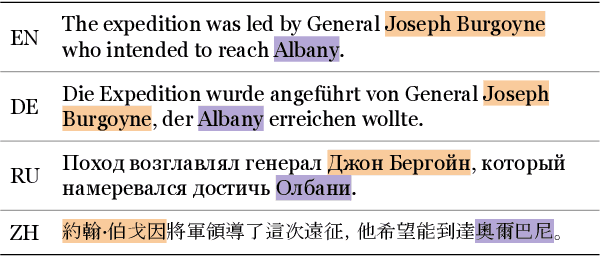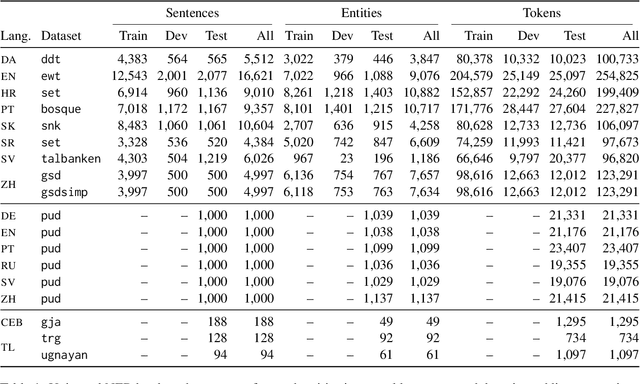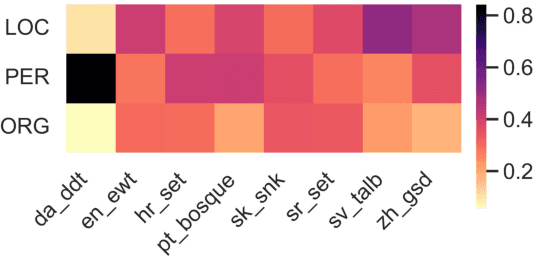Hila Gonen
Does Liking Yellow Imply Driving a School Bus? Semantic Leakage in Language Models
Aug 12, 2024Abstract:Despite their wide adoption, the biases and unintended behaviors of language models remain poorly understood. In this paper, we identify and characterize a phenomenon never discussed before, which we call semantic leakage, where models leak irrelevant information from the prompt into the generation in unexpected ways. We propose an evaluation setting to detect semantic leakage both by humans and automatically, curate a diverse test suite for diagnosing this behavior, and measure significant semantic leakage in 13 flagship models. We also show that models exhibit semantic leakage in languages besides English and across different settings and generation scenarios. This discovery highlights yet another type of bias in language models that affects their generation patterns and behavior.
MAGNET: Improving the Multilingual Fairness of Language Models with Adaptive Gradient-Based Tokenization
Jul 11, 2024



Abstract:In multilingual settings, non-Latin scripts and low-resource languages are usually disadvantaged in terms of language models' utility, efficiency, and cost. Specifically, previous studies have reported multiple modeling biases that the current tokenization algorithms introduce to non-Latin script languages, the main one being over-segmentation. In this work, we propose MAGNET; multilingual adaptive gradient-based tokenization to reduce over-segmentation via adaptive gradient-based subword tokenization. MAGNET learns to predict segment boundaries between byte tokens in a sequence via sub-modules within the model, which act as internal boundary predictors (tokenizers). Previous gradient-based tokenization methods aimed for uniform compression across sequences by integrating a single boundary predictor during training and optimizing it end-to-end through stochastic reparameterization alongside the next token prediction objective. However, this approach still results in over-segmentation for non-Latin script languages in multilingual settings. In contrast, MAGNET offers a customizable architecture where byte-level sequences are routed through language-script-specific predictors, each optimized for its respective language script. This modularity enforces equitable segmentation granularity across different language scripts compared to previous methods. Through extensive experiments, we demonstrate that in addition to reducing segmentation disparities, MAGNET also enables faster language modelling and improves downstream utility.
Voices Unheard: NLP Resources and Models for Yorùbá Regional Dialects
Jun 27, 2024Abstract:Yor\`ub\'a an African language with roughly 47 million speakers encompasses a continuum with several dialects. Recent efforts to develop NLP technologies for African languages have focused on their standard dialects, resulting in disparities for dialects and varieties for which there are little to no resources or tools. We take steps towards bridging this gap by introducing a new high-quality parallel text and speech corpus YOR\`ULECT across three domains and four regional Yor\`ub\'a dialects. To develop this corpus, we engaged native speakers, travelling to communities where these dialects are spoken, to collect text and speech data. Using our newly created corpus, we conducted extensive experiments on (text) machine translation, automatic speech recognition, and speech-to-text translation. Our results reveal substantial performance disparities between standard Yor\`ub\'a and the other dialects across all tasks. However, we also show that with dialect-adaptive finetuning, we are able to narrow this gap. We believe our dataset and experimental analysis will contribute greatly to developing NLP tools for Yor\`ub\'a and its dialects, and potentially for other African languages, by improving our understanding of existing challenges and offering a high-quality dataset for further development. We release YOR\`ULECT dataset and models publicly under an open license.
MYTE: Morphology-Driven Byte Encoding for Better and Fairer Multilingual Language Modeling
Mar 15, 2024Abstract:A major consideration in multilingual language modeling is how to best represent languages with diverse vocabularies and scripts. Although contemporary text encoding methods cover most of the world's writing systems, they exhibit bias towards the high-resource languages of the Global West. As a result, texts of underrepresented languages tend to be segmented into long sequences of linguistically meaningless units. To address the disparities, we introduce a new paradigm that encodes the same information with segments of consistent size across diverse languages. Our encoding convention (MYTE) is based on morphemes, as their inventories are more balanced across languages than characters, which are used in previous methods. We show that MYTE produces shorter encodings for all 99 analyzed languages, with the most notable improvements for non-European languages and non-Latin scripts. This, in turn, improves multilingual LM performance and diminishes the perplexity gap throughout diverse languages.
Breaking the Curse of Multilinguality with Cross-lingual Expert Language Models
Jan 19, 2024



Abstract:Despite their popularity in non-English NLP, multilingual language models often underperform monolingual ones due to inter-language competition for model parameters. We propose Cross-lingual Expert Language Models (X-ELM), which mitigate this competition by independently training language models on subsets of the multilingual corpus. This process specializes X-ELMs to different languages while remaining effective as a multilingual ensemble. Our experiments show that when given the same compute budget, X-ELM outperforms jointly trained multilingual models across all considered languages and that these gains transfer to downstream tasks. X-ELM provides additional benefits over performance improvements: new experts can be iteratively added, adapting X-ELM to new languages without catastrophic forgetting. Furthermore, training is asynchronous, reducing the hardware requirements for multilingual training and democratizing multilingual modeling.
Universal NER: A Gold-Standard Multilingual Named Entity Recognition Benchmark
Nov 15, 2023



Abstract:We introduce Universal NER (UNER), an open, community-driven project to develop gold-standard NER benchmarks in many languages. The overarching goal of UNER is to provide high-quality, cross-lingually consistent annotations to facilitate and standardize multilingual NER research. UNER v1 contains 18 datasets annotated with named entities in a cross-lingual consistent schema across 12 diverse languages. In this paper, we detail the dataset creation and composition of UNER; we also provide initial modeling baselines on both in-language and cross-lingual learning settings. We release the data, code, and fitted models to the public.
That was the last straw, we need more: Are Translation Systems Sensitive to Disambiguating Context?
Oct 23, 2023Abstract:The translation of ambiguous text presents a challenge for translation systems, as it requires using the surrounding context to disambiguate the intended meaning as much as possible. While prior work has studied ambiguities that result from different grammatical features of the source and target language, we study semantic ambiguities that exist in the source (English in this work) itself. In particular, we focus on idioms that are open to both literal and figurative interpretations (e.g., goose egg), and collect TIDE, a dataset of 512 pairs of English sentences containing idioms with disambiguating context such that one is literal (it laid a goose egg) and another is figurative (they scored a goose egg, as in a score of zero). In experiments, we compare MT-specific models and language models for (i) their preference when given an ambiguous subsentence, (ii) their sensitivity to disambiguating context, and (iii) the performance disparity between figurative and literal source sentences. We find that current MT models consistently translate English idioms literally, even when the context suggests a figurative interpretation. On the other hand, LMs are far more context-aware, although there remain disparities across target languages. Our findings underline the potential of LMs as a strong backbone for context-aware translation.
BUFFET: Benchmarking Large Language Models for Few-shot Cross-lingual Transfer
May 24, 2023Abstract:Despite remarkable advancements in few-shot generalization in natural language processing, most models are developed and evaluated primarily in English. To facilitate research on few-shot cross-lingual transfer, we introduce a new benchmark, called BUFFET, which unifies 15 diverse tasks across 54 languages in a sequence-to-sequence format and provides a fixed set of few-shot examples and instructions. BUFFET is designed to establish a rigorous and equitable evaluation framework for few-shot cross-lingual transfer across a broad range of tasks and languages. Using BUFFET, we perform thorough evaluations of state-of-the-art multilingual large language models with different transfer methods, namely in-context learning and fine-tuning. Our findings reveal significant room for improvement in few-shot in-context cross-lingual transfer. In particular, ChatGPT with in-context learning often performs worse than much smaller mT5-base models fine-tuned on English task data and few-shot in-language examples. Our analysis suggests various avenues for future research in few-shot cross-lingual transfer, such as improved pretraining, understanding, and future evaluations.
Do All Languages Cost the Same? Tokenization in the Era of Commercial Language Models
May 23, 2023Abstract:Language models have graduated from being research prototypes to commercialized products offered as web APIs, and recent works have highlighted the multilingual capabilities of these products. The API vendors charge their users based on usage, more specifically on the number of ``tokens'' processed or generated by the underlying language models. What constitutes a token, however, is training data and model dependent with a large variance in the number of tokens required to convey the same information in different languages. In this work, we analyze the effect of this non-uniformity on the fairness of an API's pricing policy across languages. We conduct a systematic analysis of the cost and utility of OpenAI's language model API on multilingual benchmarks in 22 typologically diverse languages. We show evidence that speakers of a large number of the supported languages are overcharged while obtaining poorer results. These speakers tend to also come from regions where the APIs are less affordable to begin with. Through these analyses, we aim to increase transparency around language model APIs' pricing policies and encourage the vendors to make them more equitable.
Dictionary-based Phrase-level Prompting of Large Language Models for Machine Translation
Feb 15, 2023



Abstract:Large language models (LLMs) demonstrate remarkable machine translation (MT) abilities via prompting, even though they were not explicitly trained for this task. However, even given the incredible quantities of data they are trained on, LLMs can struggle to translate inputs with rare words, which are common in low resource or domain transfer scenarios. We show that LLM prompting can provide an effective solution for rare words as well, by using prior knowledge from bilingual dictionaries to provide control hints in the prompts. We propose a novel method, DiPMT, that provides a set of possible translations for a subset of the input words, thereby enabling fine-grained phrase-level prompted control of the LLM. Extensive experiments show that DiPMT outperforms the baseline both in low-resource MT, as well as for out-of-domain MT. We further provide a qualitative analysis of the benefits and limitations of this approach, including the overall level of controllability that is achieved.
 Add to Chrome
Add to Chrome Add to Firefox
Add to Firefox Add to Edge
Add to Edge